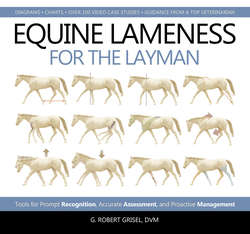Читать книгу Equine Lameness for the Layman - G. Robert Grisel DVM - Страница 44
На сайте Литреса книга снята с продажи.
Оглавление11 Axial versus Peripheral Lameness
We generally think of lameness affecting the horse’s limbs, but irregular movement can also be demonstrated between different sides of the horse’s axial skeleton, such as the neck and back. Axial lameness almost always occurs in conjunction with limb lameness because the head, neck, and trunk serve as powerful tools for transferring weight and maintaining balance (VL 11a). As a matter of fact, the adept observer will usually appraise movement of the horse’s median anatomy at the outset of assessment (chapter 20), since it can provide valuable clues with regard to the region(s) or limb(s) that should be evaluated next.
VL 11a Scan/Click to view video. www.getsound.com/tutorials/11a
Appropriately, many practitioners will presume that axial asymmetry is either artificial (referred) or compensatory if it coexists with peripheral lameness. In these instances, the median anatomy will assuredly display unnatural movement to adjust for gait deficits in one or more limbs, thereby making it extremely challenging for the observer to validate the primary contribution of any axial component.
Interestingly, horses with authentic axial lameness are more likely to avoid movement altogether as opposed to moving irregularly. As previously discussed (in chapter 5—p. 26), the relative proximity between contralateral axial structures in combination with the horse’s emphatic desire to safeguard painful areas can make effective assessment of the median anatomy (by itself) very perplexing.
For these reasons, it is important that we do everything at our disposal to simplify the process: observing the horse on a regular basis (from one day to the next), asking the horse to move in concentrically smaller circles and appraising the effect of a rider’s weight are all common techniques intended to clarify our visual assessment of head, neck, and back motion.
The Head and Neck
The horse’s head and neck are quite heavy, accounting for almost 10% of the entire body weight. The head is located a considerable distance from the trunk on account of the appreciable length of the neck. As such, it serves as an extremely effective means for transferring weight, particularly that associated with the front end. It is also a very large and visibly prominent structure that can be easily tracked with our eye. Based on these characteristics, the horse’s head can essentially be considered a peripheral structure that aptly awards the observer with an explicit marker for assessing lameness. In combination with the withers, the head and neck are evaluated foremost during visual lameness assessment (see chapter 23 and VL 11b).
VL 11b Scan/Click to view video. www.getsound.com/tutorials/11b
Notwithstanding, the horse’s head also embodies the aspect of anatomy most often utilized to emit emotion, such as anxiety or resistance. Abnormal movement related to these forms of expression can be very difficult to interpret, and should, therefore, be considered in conjunction with how the rest of the horse’s body is moving.
